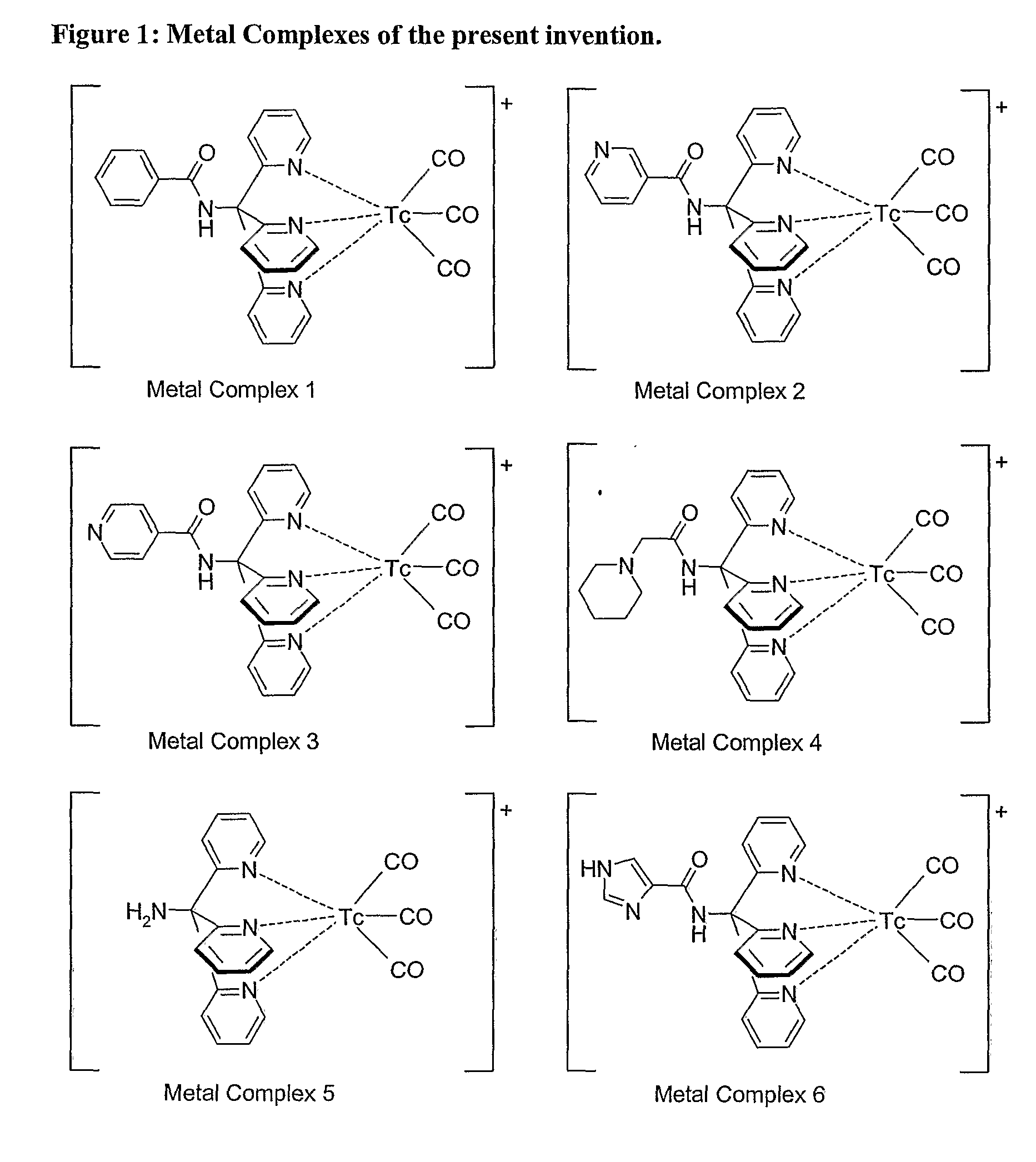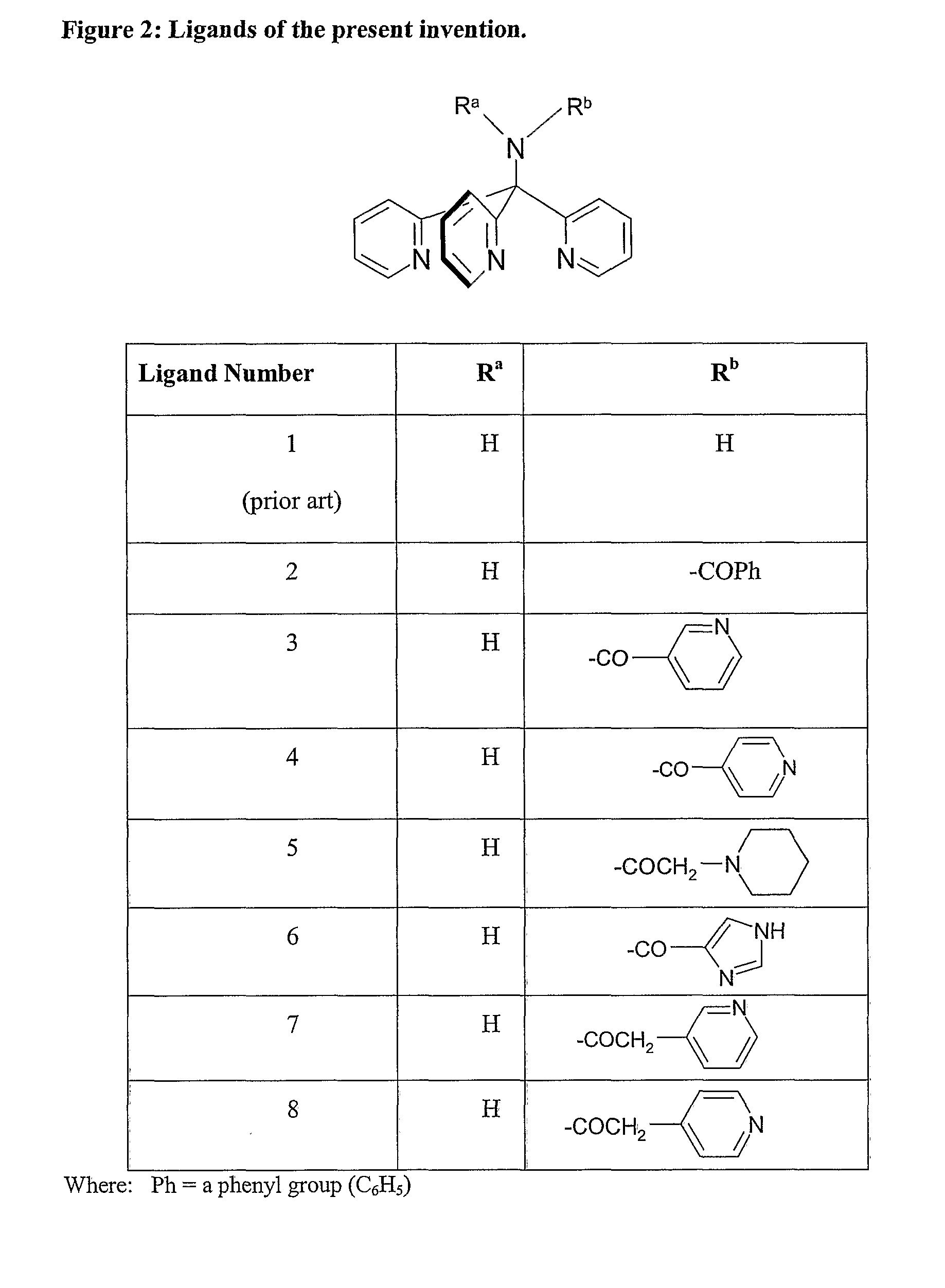Novel Technetium and Rhenium Complexes.
a technology of rhenium complexes and radioactive technology, applied in the field of radioactive technology of tc and rhenium complexes, can solve problems such as unsuitable chemical substitution
- Summary
- Abstract
- Description
- Claims
- Application Information
AI Technical Summary
Benefits of technology
Problems solved by technology
Method used
Image
Examples
first embodiment
where L is a ligand of Formula I as defined for the first embodiment,
[0048]M is a radioactive isotope of technetium or rhenium;
[0049]X is selected from CO, halogen, phosphine or isonitrile, and
[0050]n is the charge on the metal complex, and can be −1, 0, +1 or +2.
[0051]When X is an isonitrile, it is suitably a monodentate isonitrile. When all three X groups are phosphines, the three X donor atoms may be made up of three monodentate phosphines, a single tridentate phosphine or a mixture of a monodentate and a bidentate phosphine.
[0052]The charge on the metal complex (n) of Formula II will depend on the donor atoms present in the ligand (L) and the identity of X. Thus, e.g. when X is CO, phosphine or isonitrile these are neutral donors and do not affect the charge. When X is halogen, however, these are negatively charged donors. When R1 of the ligand of Formula I is —CH2SH it is anticipated that metal complexation occurs via a thiolate anion, i.e. the thiol is deprotonated so that the...
experimental examples
[0091]Ligand 1 [i.e. 1,1,1-tris(pyridin-2-yl)methylamine] was prepared by the method of Arnold et al [JCS Dalton Trans., 736-746 (2001)].
example 1
Synthesis of Ligand 2
[0092]Benzoic anhydride (280 mg, 1.24 mmol) was added in one portion to a stirred solution of Ligand 1 (250 mg 0.95 mmol) in CH2Cl2 (2 ml) at room temperature. Stirring was continued for 24 hours and the reaction mixture diluted with CH2Cl2 (18 ml). This solution was washed with saturated sodium bicarbonate (20 ml×2) and water (20 ml×2), and then dried (MgSO4), filtered and the solvent evaporated to leave a yellow residue. Recrystallisation of this material from a CH2Cl2 / pentane mixture gave the product (180 mg, 52%) as a yellow powder, m p 233-234° C.
[0093]1H NMR (CDCl3): δH 7.10-7.17 (3H, m, 5-H), 7.41-7.51 (3H, m, 4-H), 7.59-7.64 (6H, m, 3-H[x2], meta-H[x2],para-H), 8.0 (2H, dd, J=7 and 2 Hz, ortho-H [x 2]), 8.53 (3H,br d, J=5 Hz, 6-H [x3]).
[0094]Mass Spec (ES) m / e:—Calculated for C23H19N4O (M+H) 367 Found 367
PUM
| Property | Measurement | Unit |
|---|---|---|
| optimal energy | aaaaa | aaaaa |
| half life | aaaaa | aaaaa |
| radioactive | aaaaa | aaaaa |
Abstract
Description
Claims
Application Information
 Login to View More
Login to View More - R&D
- Intellectual Property
- Life Sciences
- Materials
- Tech Scout
- Unparalleled Data Quality
- Higher Quality Content
- 60% Fewer Hallucinations
Browse by: Latest US Patents, China's latest patents, Technical Efficacy Thesaurus, Application Domain, Technology Topic, Popular Technical Reports.
© 2025 PatSnap. All rights reserved.Legal|Privacy policy|Modern Slavery Act Transparency Statement|Sitemap|About US| Contact US: help@patsnap.com



